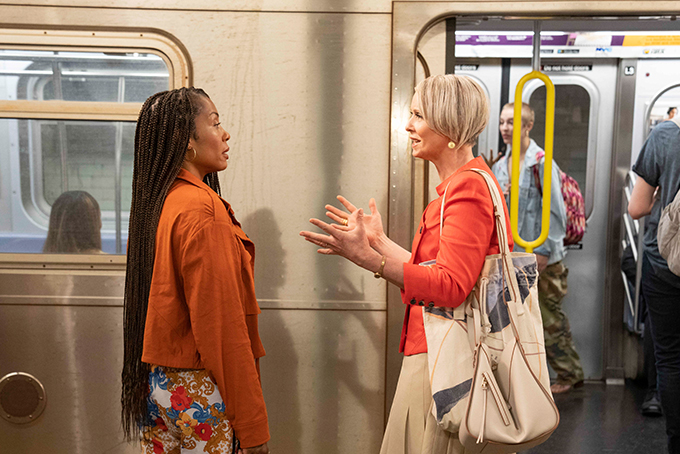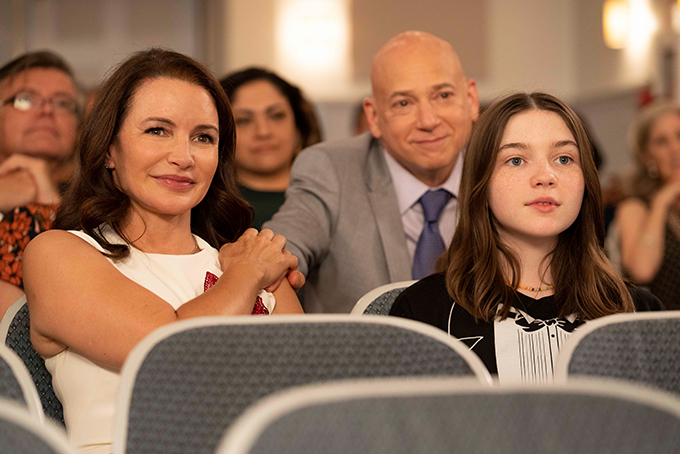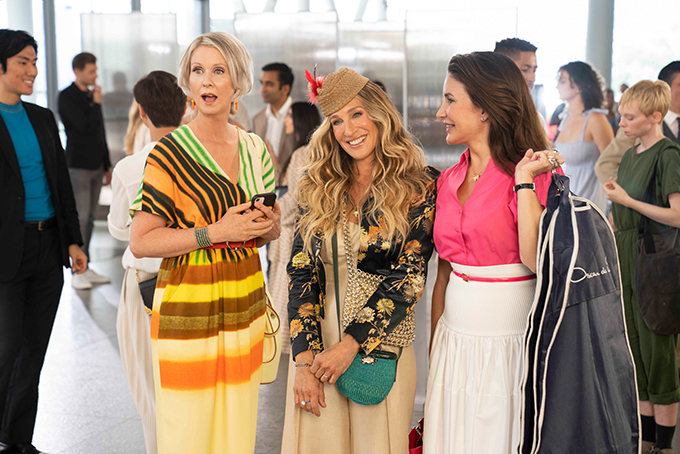Spoiler alert: This story contains spoilers for the first three episodes of And Just Like That.
In the first episode of HBO GO’s new Sex and the City revival And Just Like That, Miranda says: “Everyone was looking at me like I was the white lady who couldn’t stop saying the word ‘black’. I think I was just so worried about saying the wrong thing in this climate that I said all the wrong things.” She’s speaking, of course, about her hysterical first day back at university as a masters student trying to obtain a degree in human rights, where she immediately ices a room full of her classmates by rambling on about her black professor’s braids.
“Will these characters be shown as complex individuals with challenges of their own, or will they remain sounding boards for their respective white leading ladies?”
Now 55 and having left corporate law behind, Miranda’s intentions are ever-noble: she wants to “become an advocate for women who need one.” But her entrance amongst her much younger peers—one of whom has purple hair (obviously) and immediately schools her on pronouns—mirrors the challenge of relevance And Just Like That faces on the heels of its release in 2021, 17 years after the original show’s last season aired.

Sex and the City has long been immortalised as one of the most iconic pieces of television of our era for its incredible fashion and oestrogen-fuelled storylines that resonated with its viewership just enough while still being out of reach. It had several blind spots, obviously, but it was of its time with its first ever episode airing in 1998—back when a cast comprised entirely of cis, straight, white characters (save one token gay best friend) was still acceptable and commonplace.
It’s a relief to see that And Just Like That has made several attempts to catch up. There are a host of interesting new characters to meet that make up a much more inclusive ensemble. Charlotte (still happily married to Harry) has two teen daughters, one of whom is Asian and drops zingy one-liners about being adopted. The other confesses something brave to her mother that leaves Charlotte reeling, but opens up the potential for a tender, timely storyline about gender identity that, if done right, could have a real impact on its audience.

Speaking of gender, Sara Ramirez plays Che Diaz, an attractive, non-binary stand-up comedian who runs the LGBTQ-friendly and sex-oriented podcast Carrie is regularly a part of. Miranda, on the other hand, starts to slowly bond with her black professor Dr. Nya Wallace, who dishes out a lesson or two on the former’s white saviour complex—displaying a level of self-awareness that Sex and the City may not have possessed, but And Just Like That definitely has.
‘The winding exploration of grief that follows is masterfully executed—deeply sentimental and yet not an inch out of place in a show that is, at its core, convivial’
Charlotte has a new black friend too—a fellow power-mum at her school with an A-plus accessory game. This is all very well and good for the first two episodes, but the real opportunity lies in the ones that follow: will these characters be fleshed out and shown as complex individuals with challenges of their own beyond the ones tied to their most visible identities? Or will they remain sounding boards for their respective white leading ladies—serving only to give them woke-cred in this era?

The show will answer this question with time and in the eight episodes to come, but feels deeply earnest and promising in its endeavour to include a wider range of voices in its glamorous universe. This optimism comes, in part, due to the nostalgia factor. But more importantly, it stems from the likability of the three main characters. If it seems like Carrie isn’t getting much screen-time in this review, it’s because age has done her well—for one, she is happily settled down with Big. The electric chemistry in the relationship so central to the original show still shines through, but is tempered by the stability of long-term commitment and the context of a pandemic. Carrie has also moved on to new media (an important plot point, as it is used to explain why fan-favourite Samantha played by Kim Cattrall is no longer a part of the show) and references the street style page she runs on Instagram in the first 15 minutes of episode one.
It’s an easy way of contextualising how the characters have evolved in the nearly two decades we didn’t see them—and evolved they most certainly have. There is a delight in unpacking the signs of age each one shows: Miranda is no longer a redhead and proudly wears her hair grey, Carrie is calm and less focused on herself, and Charlotte—well, Charlotte is still Charlotte. They talk openly about their age (the number 55 is thrown around a lot) and it is in these discussions that the show is most fondly reminiscent of its predecessor. The back-and-forth they share, the empowered (but not always, because who is a perfect feminist?) pep talks they take turns performing will bring fans of the original show right back to Carrie’s Manhattan apartment.

So, the good news is: the reboot is still fun. The characters are still lively and impossible not to like, and each episode brings with it a myriad of plot-lines that branch off into a hundred more, some comedic and some less so. There is death, which comes as a surprise when it does, but maybe shouldn’t given how hand-in-hand it is with ageing. The winding exploration of grief that follows is masterfully executed—deeply sentimental and yet not an inch out of place in a show that is, at its core, convivial. Halfway through the second episode, in the middle of a funeral, Stanford says it best as he sizes up Carrie’s outfit: “I’m so proud of her. With all she’s going through, pulling it together and giving us a look today—because she knows people will be expecting it. She’s kind of our Jackie Kennedy.”
And Just Like That is now streaming on HBO Go.





